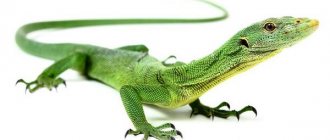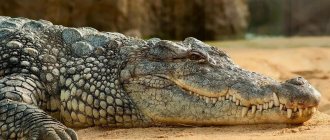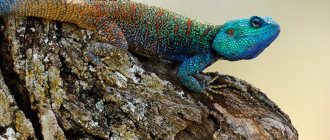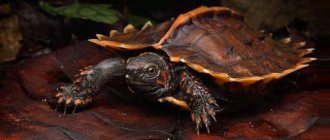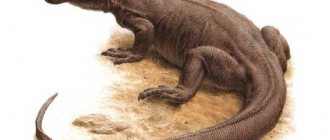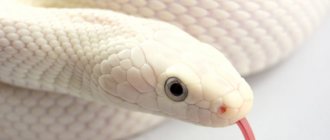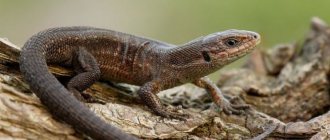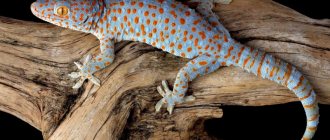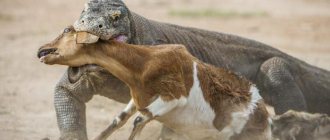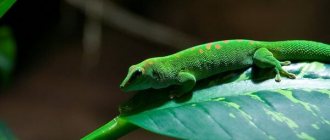Can lizards stick out their tongues? They really can, especially when it’s blue! No, you heard right - a lizard with a blue tongue really exists. And her name is blue-tongued skink.
These creatures are reptiles from the order of scaly lizards. Skinks belong to the skink family.
Today, about 7 species of blue-tongued skinks live on our planet.
Blue tongue skink (Tiliqua multifasciata)
Description of the lizard and structural features
Lizards are usually called all reptiles with legs, as well as some legless forms. The species diversity of lizards is very high: according to the latest estimates of scientists, today there are almost 6,000 species of tailed reptiles in the world. Representatives of various families differ in size, color, habits, habitat; some exotic species are listed in the Red Book. In nature, the most common reptile can be considered a true lizard, the average body length of which is 10-40 cm.
Unlike snakes, lizards have movable, divided eyelids. The lizard's body is elastic, elongated, ending in a long tail. The lizard's paws are proportional, clawed, and of medium length. The reptile's body is covered with keratinized scales, which peel off several times during the season as a result of molting.
The lizard's tongue can have different shapes, colors and sizes; it is usually movable and easily pulled out of the mouth. It is with their tongue that many lizards catch prey.
Lizard tongue blue tongue skink
Lizards' teeth are used to capture, tear and grind food. Monitor lizards have teeth that cut prey.
The only poisonous lizard is the poison tooth; when it bites, it injects poison into its victim, thus killing it.
Description
The common quick lizard belongs to the category of amphibians and reptiles, family of true lizards, order Squamate. Amphibians belong to the largest group of reptiles and the most widespread species in Europe and Asia.
Its color changes in different habitats: there are individuals painted in a single color. But mostly they have a pattern on their back. The amphibian reptile is very similar to a snake, but has differences:
- fast paws;
- movable eyelids;
- excellent hearing.
There are more than five thousand species of this reptile in the world. Some species tend to shed their tails when threatened.
The sand lizard is the most common species on the European continent. It has a distinctive feature - stripes are clearly visible on the back.
In the wild, there are reptiles that are green, gray, and brown. The female has a duller color, the male is very bright. The incredibly fast and dexterous reptile got its name due to its nimble behavior. Females of this species can eat their offspring.
What does it look like
Reptiles have a body size of 25 to 28 cm. The appearance is almost the same as that of tailed amphibians, only they have a more slender body.
Lizard structure:
- the head has a pointed shape, nostrils are located at the end of the muzzle;
- the neck is thick, shortened;
- the eyes are covered with eyelids. There is also a third eyelid in the form of a special nictitating membrane, which serves to moisturize the organs of vision;
- Behind the eyes there are round eardrums, which help the fast lizard to have absolute hearing;
- the tongue, as an organ of touch, is thin, long, its tip is forked. The reptile uses it to explore the surface when protruding from its mouth.
The lizard's paws are similar to frog legs with five toes without membranes, with claws that help them run quickly and dexterously. The skin on the body is dry, covered with horny scales. The muzzle and abdomen are covered with larger scales, similar to protective shields.
As they grow, they begin to molt, a process that occurs once every four or five years. Amphibians breathe only with the help of their lungs.
The color of males is varied; there are individuals of green, olive or black color. During breeding, the males' coloring becomes bright and attractive. Females are gray or brown and decorated with different patterns. Juveniles are not very bright; they are gray with three stripes on their backs.
Character and lifestyle
Agile lizards lead a daily life. The nimble reptiles can run fast, climb high, jump well, instantly change the direction of movement, and catch flies and other flying insects on the fly. For this they were called quick.
For housing they use minks that they dig themselves. They also use burrows dug by other animals. They are always close to the house and can move no more than 15 meters during a hunt. If danger overtakes them, they deftly run away.
Reptiles behave very carefully; when any kind of danger appears, they hide in a hole or climb a plant. If an overtaking predator grabs her by the tail, she throws back this part of her body and thereby saves her life.
It spends the cold season hibernating in its burrow, and with the advent of warm sunlight, it leaves its home and begins active hunting.
In the vicinity of her burrow there will always be a warm place warmed by the sun; after a hunt, she rests on a hot stone, a piece of land, on a fence or a stack of firewood. Her body is positioned in the sun in such a way as to warm it up to all the bones.
At the beginning of autumn, reptiles hide in burrows and hibernate.
What do they eat?
Lizards are omnivores, but they consume more food:
- Zhukov;
- grasshoppers;
- butterflies;
- caterpillars;
- spiders;
- locusts;
- snails;
- earthworms.
Having chosen a victim, the animal sneaks up on it unnoticed, then quickly jumps, grabs it with its claws and bites it with its teeth. They also eat vegetarian food, eat pollen and ripe fruits. They eat the fruits of cherries, cherries, grapes, viburnum, and tree leaves.
Where does it live?
The sand lizard prefers to live in a temperate continental climate. She is not particularly demanding of her habitat, but she prefers areas of dry territory, where shrubs are occasionally scattered and there are free, bright places to receive sunlight.
It is usually found on the edge of a forest, the side of a road, or the slope of a ravine or hill. It lives along railway embankments, in the ruins of old buildings, in suburban summer cottages, in gardens and parks.
An indispensable condition for habitat should be a piece of land with light soil, not overgrown with grass, where you can easily dig a hole for yourself. Reptiles are found at altitudes of up to 700m, but in southern places they live at an altitude of about 3500m above sea level.
Habitat:
- forest, forest-steppe, semi-desert zones of Europe and Asia;
- southern England, eastern France;
- Baikal region and southern Transbaikalia.
Sometimes they are found in the southern taiga, in the subtaiga forest, and in the northern forest-steppe. Populations are isolated, living at the edge of the forest, along the road. They populate along the side of the highway, on drained raised bogs, on the banks of canals, on dams and reclamation shafts.
Reproduction
The mating season of sand lizards lasts from early spring until mid-June. Males prepare a festive outfit, the shirtfront under the throat and the barrel take on an emerald green color. The female remains in her usual gray color.
During this period, the males become animated, quickly run around the surrounding area and constantly rise on their paws. When meeting with an opponent, fights begin. The winner gets the right to his chosen one.
Seeing the female, the winner begins to pursue her. If you manage to catch it, it grabs the base of the tail, pinches it with its paws and mates.
After the mating process, the female looks for a sun-warmed area and digs a hole in the loose soil to lay eggs. At the end of June, a pregnant reptile lays up to 15 large eggs in soft shells and buries them in a prepared burrow.
After 9 weeks, the cubs are born. The embryo develops inside the egg, and a fully formed young lizard emerges, up to 34 mm long and weighing up to 0.9 g.
The coloring of the young animals is dark, with almost no light specks visible on the sides. Strong males are not averse to eating small cubs.
Sexual maturity occurs in the second year of life, after the second winter. Depending on their habitat, females breed either once or twice a year.
Natural enemies
In the wild, these animals have many enemies. They are food for:
- snake;
- storks;
- cranes;
- kingfishers;
- crow;
- shrikes;
- small falcons;
- hoopoe
To protect themselves from birds of prey, reptiles:
- try to run fast;
- abruptly change direction;
- bury themselves in the sand;
- freeze;
- camouflaged on the back of tree trunks.
Predatory animals also pose a threat; lizards are eaten by foxes, bears, wolves, and martens. Sometimes even cats eat reptiles. And snakes are their main dangerous enemies.
The caught animal sharply throws off part of its tail, bites, and tries to deftly wriggle out. Their life expectancy is 5 – 6 years.
Wintering
Lizards spend the winter in their area of residence. They prepare in advance for the cold winter time and prepare a place for hibernation in warm burrows.
They choose a variety of shelters - heaps of branches, the remains of a felled tree. Summer residents often observe reptiles hibernating under a greenhouse film - for them it is warm and dry there, because the film does not allow moisture to pass through.
Like many reptiles, the fast lizard falls asleep or “freezes” during cold weather. By spring they “thaw”, or wake up.
Lizard skin
How are snakes different from lizards?
Some lizards, such as copperheads, are mistaken for snakes. Undoubtedly, the lizard is similar to the snake, at least some species have such a resemblance. Lizards, unlike snakes, have paws. But how can you tell a legless lizard from a snake?
- The factor that makes it possible to unmistakably distinguish these creatures is the eyelids: in snakes they have grown together and become transparent, so representatives of this family do not blink, but in lizards the eyelids remain mobile.
- The snake's hearing organs are completely atrophied, while the lizard has ear openings on both sides of its head, covered by eardrums.
- Snakes and lizards are susceptible to the molting process in completely different ways: the former try to shed their skin immediately, after “soaking” in a pond, while lizards shed in “pieces”.
Features of lizard anatomy
Lizards (lat. Lacertilia) are a suborder of reptiles from the order Scaly. In the suborder of lizards, thirty families are distinguished, the most famous of which are: iguanas, eublepharidae, monitor lizards, chameleons, agamidae, geckos, skinks, spindles. Moreover, the modern classification includes approximately six thousand species of lizards distributed throughout the world. Being a separate suborder of reptiles, lizards have significant differences in their anatomy and physiology, both relative to other suborders (crocodiles, turtles, snakes) and other orders of vertebrates (amphibians, birds, mammals). In addition, a significant number of species and their adaptation to certain environmental conditions have led to a certain number of differences in the anatomy among the lizards themselves (for example, the anatomy of a chameleon differs from the structure of a gecko or skink). Here are only structural features common to most lizards. The cardiovascular system. The heart consists of three chambers - two atria and a ventricle. In the ventricle (conditionally) there are venous, arterial and pulmonary cavities. The venous cavity receives deoxygenated blood from the right atrium, and the arterial cavity receives oxygenated blood from the left atrium. However, the presence of a muscle flap that acts as a cardiac septum and two-beat contraction of the ventricle reduces blood mixing. Therefore, being anatomically three-chambered, the heart functions like a similar four-chamber organ in a mammal. Lizards also have a feature characteristic of all reptiles - the renal portal system. A blood supply scheme in which all the veins of the tail and part of the veins of the pelvic limbs carry blood directly to the kidneys, bypassing other tissues and organs, which must be taken into account when administering drugs parenterally. Respiratory system. A number of herbivorous species (for example, the green iguana) have special organs in the nasal passages - salt glands, due to the work of which sodium and potassium salts are removed from the reptile's body (without significant loss of fluid).
The lungs of primitive species have a spongy structure and are thin-walled cavities divided into faveoli. In more advanced reptiles, the lungs are divided into septa. Lizards do not have a diaphragm. The process of gas exchange is carried out due to contractions of the chest. Support and movement system. There are ribs on each vertebra of all parts of the spinal column, except the caudal one. Many lizards are characterized by autotomy (the ability to discard part of the tail in case of danger). Digestive system. Lizards' lips are motionless. Lizards do not have poisonous teeth (the only exception is the poison tooth). Teeth are adapted for a variety of functions, depending on the feeding method of a particular species, and come in two types. Most often these are pleurodont teeth attached to the sides of the jaw. However, agamidae and chameleons are characterized by acrodont-type teeth attached to the chewing edge of the jaw. Pleurodont teeth are replaced constantly, while acrodont teeth are replaced only in young animals. The structure of the tongue varies depending on dietary adaptations. It is usually a very mobile organ. Taste receptors (special tubercles) are present in lizards with soft tongues and are absent, for example, in monitor lizards, whose tongue is covered with keratin. In addition, taste buds are also located in the mucous membrane of the pharynx. There are many species-specific features in the structure of the digestive system. Monitor lizards have a significant bifurcation of the tip of the tongue, with the help of which they capture molecules of substances from the air and redirect them to the Jacobson (vomeronasal) organ responsible for the sense of smell. In chameleons, the tongue is the most important organ, without which feeding in the wild is almost impossible. The bright red end of the tongue is always a sign of the norm for the common (green) iguana. An additional organ of smell, the so-called Jacobson organ (paired), is found in the form of small holes on the inner surface of the upper jaw, in front of the internal nostrils of reptiles. The stomach of lizards is primitive, curved. Unlike birds (which do not have teeth), lizards do not normally swallow stones to optimize the digestive process. The large intestine is thin-walled, with a poorly developed muscle layer (compared to the thin section and stomach). The cecum is present in most species. The colon of herbivorous lizards can be divided into chambers, which facilitates the process of breaking down the coarse fiber of the food. The cloaca is traditionally divided into coprodeum, urodeum, and proctodeum. Urinary system. The kidneys of lizards are metanephric.
They can be attached to the posterior part of the coelom or to the pelvic canal. The posterior pole of the kidneys (sexual segment) in a number of species (skinks, iguanas) has differences in appearance in individuals of different sexes. Products of nitrogen metabolism are excreted primarily in the form of breakdown products: uric acid, urea or ammonia. Urea and ammonia are produced in aquatic and semi-aquatic species of lizards, uric acid - in desert and semi-desert species (which reduces water loss during urination). Almost all lizards have a bladder. If it is absent, urine accumulates at the end of the colon. The kidney does not contain a pelvis and does not have loops of Henle, as a result of which it cannot concentrate urine. But in the bladder, the fluid is absorbed back, so urine is still excreted from the body in concentrated form. Reproductive system. During the rutting period, the reproductive segment increases in size (due to participation in sperm production) and may change color. The color intensity and color of the reptile’s skin may also change. Fertilization is internal. Males have so-called hemipenises (paired copulation organs). Normally, the hemipenes are located at the root of the tail (they can be found as tubercles under the skin). The hemipenises are in no way connected with the process of urination and are involved only in the process of transferring seminal fluid. The female reproductive system consists of paired oviducts and ovaries. To clarify/determinate sex (mainly in large individuals of iguanas and monitor lizards), it is possible to conduct a sex test (similar to sex determination in snakes). According to the method of reproduction and bearing offspring, lizards can be divided into oviparous, ovoviviparous (the eggs are kept in the female’s body until the young are born), viviparous, and those that reproduce by parthenogenesis (without males). Nervous system The brain of lizards is better developed than that of amphibians and fish. Unlike mammals, the spinal cord occupies space in the spinal column before completing the caudal region. Organ of vision. In general, the structure of a reptile's eye is similar to other vertebrates.
The eyelids are movable. There is a nictitating membrane. The peculiarity is that the iris includes striated, rather than smooth, muscles. The pupil shape is round for daytime species and vertical for nocturnal species. The lens is motionless; its shape changes due to contraction of the muscle fibers of the ciliary body. The pupil reflex is not expressed. The retina does not have its own vessels and is nourished by a large choroid plexus that penetrates the vitreous body. Some species of lizards have a so-called third eye, located on the head (in the area of the parietal bone). This organ contains the retina and lens, which interact with the pituitary gland. The third eye does not perceive light, but plays an important role in the formation of hormones and heat exchange. Organ of hearing. The tympanic membrane is covered with skin on top.
There are two main auditory ossicles - the stapes itself and the stapes process. The middle ear cavities communicate with the pharynx via the Eustachian tubes. Lizards, belonging to a developed order of the reptile class, have common patterns of anatomical structure. However, taking into account the significant species diversity and varying degrees of evolution and adaptation of individual organs and systems, this material is of a generalized, review nature. When studying a particular species, one should always take into account the diversity of species characteristics caused by dietary adaptations, habitat and lifestyle. This nuance is extremely important for veterinary herpetology.
Veterinarian Artem Arkadievich Kazakov
Veterinarian Pererva Lyudmila Viktorovna
How to distinguish a newt from a lizard?
Undoubtedly, newts and lizards have similarities: a flat or slightly rounded tail, a similar structure of the legs and body, a “snake-like” head, a multifaceted color palette of skin coloring, movable eyelids covering the eyes. It is quite easy to confuse a newt and a lizard. And yet, a newt can be distinguished from a lizard by certain characteristics:
- Among the external differences, it is worth noting the completely different type of skin: in lizards it is scaly, but in newts the skin is completely smooth, mucous to the touch.
- As for the tail, newts do not have the ability to cast it off and regenerate it, while the lizard easily and “carefree” gets rid of this part of the body in case of danger.
There are differences in the structure of the organs:
- A feature of lizards is a hard, ossified skull, but in the newt it is cartilaginous;
- The lizard breathes with its lungs; in the newt, the respiratory system involves both the lungs, residual gills, and skin;
- Lizards are viviparous or lay eggs - depending on the species, the newt prefers to reproduce in the water element according to the principle of spawning.
Lizard: description
Usually all reptiles with legs are considered lizards, but they also include several without legs. There are a lot of species of lizards; according to zoologists, more than 6,000 different species of lizards live on our planet, and all of them, of course, differ in their habits, appearance, color and habitat. Some of the especially exotic species of lizards are currently on the verge of extinction and for this reason are listed in the Red Book.
The most common real lizard has a body length of 10-40 cm. The lizard's body is long, elastic, elongated and has a long tail.
Unlike their snake relatives, lizards have movable and divided eyelids. The lizard's paws are of medium length, have claws and are generally proportional to its body covered with keratinized scales. The lizard's skin peels off during molting a couple of times per season; in some languages of the world, this amazing feature of these reptiles to change their skin even gave them their name. In particular, in our language the word “lizard” comes from the Old Russian word “skora”, which means “skin”, or “skin” if more literary.
The lizard's tongue, depending on the species, has a different shape and size; in general, it is mobile and easily protrudes from the mouth. And some lizards even use their tongues to catch fish.
- Cross spider
- Reptiles
- 72 facts about plants
- Animals of Siberia
- 35 facts about giraffes
- Animals of Crimea
Lizards' teeth are also their weapons; with their help, they capture and grind food, and monitor lizards have sharp teeth that literally cut prey. There is also a single poisonous representative among lizards, named accordingly - the poisonous tooth, which, with a bite like snakes, injects poison into its victim, thus killing it.
The skin of a lizard can have a variety of colors and patterns, depending on the species.
The color (color) of the lizard also differs, which many species are able to change depending on the situation, sometimes literally merging with the surrounding area - color mimicry is one of their main means of defense. Typically, lizards have a combination of gray, brown and green colors.
Lizard tail. How does a lizard cast its tail?
Most lizards have an important feature: the ability to autotomy (throwing away the tail), which they are forced to use in emergency situations. Muscle contraction allows the cartilaginous formations of the vertebrae to be broken and most of the tail to be thrown away, while the blood vessels narrow and there is virtually no blood loss. For some time, the tail wriggles, distracting the enemy, and the lizard is able to avoid the attack. The reptile's tail recovers quite quickly, albeit in a slightly shortened form.
Sometimes a lizard grows back not one, but two or three tails:
Respiratory organs of a lizard
If you open the lizard's mouth wide (Fig. 3), behind the tongue we will see a gap in the breathing hole, which can be expanded by inserting thin tweezers into it (Fig. 3, 5). The breathing hole leads into a special chamber—the larynx, the walls of which, so that they do not collapse, are supported by a system of cartilage. Of the cartilages, we note the cricoid and two arytenoids. Behind the larynx goes down the windpipe, or trachea, which is a long tube whose walls are supported by numerous cartilaginous rings. At the lower end, the trachea branches into two bronchi. Each of them enters the corresponding lung, which has the shape of an elongated sac with a network of delicate internal crossbars (Fig. 2, 7-8).
Article on the topic Structure of a lizard
Color (color) of a lizard
Lizards come in a variety of colors, usually consisting of a combination of green, gray and brown. Lizards that live in the desert usually exactly repeat the color of their main habitat - this is how their defense mechanism manifests itself. Thus, desert lizards are able to change body color.
Gecko
Chameleon - a lizard that changes color
How to distinguish a male from a female lizard?
There are a number of signs by which it is possible, but unfortunately not always as accurately as possible, to determine the sex of a lizard. The most important thing is that it is possible to distinguish a male lizard from a female only at sexual maturity, since sexual dimorphism in these individuals develops extremely late.
- The males of some lizard species, such as green iguanas and basilisks, have a brightly colored crest on their back and head, as well as large pores on their thighs.
- Another attribute of a “man” in lizards is spurs on their paws.
- Sex can be determined by the throat “bags”, preanal scutes, or a pair of enlarged scales just behind the cloaca that are present in some varieties.
In principle, all these methods are imperfect: if you need to find out the sex of a lizard with one hundred percent accuracy, then only a blood test for testosterone levels done in a professional veterinary clinic can help.
Iguanas
This infraorder includes the families of iguanas, chameleons and agamidae. Most of the species included in this taxon have a spiny crest. It runs along their entire body, along their back and to the tip of their tail. In addition, there are two more distinctive features. There are growths on the head of this type of lizard. In addition, they also have throat sacs, which serve them to give signals when danger arises and during the mating season. The bulk of animals of this infraorder live in trees.
Some of the most popular representatives of these animals are the steppe agama and the Yemen chameleon. Among their relatives they are the largest in size. An adult chameleon can reach 60 centimeters in length, and an agama can reach thirty. A distinctive feature of these two types of reptiles is their ability to change body color. When threatened, the chameleon turns brown, merging with the tree trunks. It is noteworthy that, like the motley roundhead, its body can only be painted in dark colors. His body cannot accept bright shades. But this feature is inherent in the agama. At rest, the body of this animal is gray in color, and in case of danger or heating in the sun, it becomes covered with bright blue, yellow and black spots.
Types of lizards, names and photographs
Scientists divide the species diversity of lizards into 6 infraorders, consisting of 37 families:
- infraorder skinks (Scincomorpha)
includes 7 families, which include:
- true lizards living in Eurasia, Africa and the USA,
- night lizards inhabiting Cuba and Central America,
- Gerrosaurs - “residents” of the Sahara and about. Madagascar,
- skinks - live everywhere, mainly in the tropics,
- Teiids - live in South and Central America,
- belted tails - live south of the Sahara and Madagascar,
- gymnophthalmids - distributed from southern Central America to southern South America.
Large Gerrosaurus Gerrhosaurus major
- infraorder iguana-like (Iguania)
has 14 families, the most prominent representative of which is the chameleon, inhabiting Africa, Madagascar, the Middle East, Hawaii and some American states;
Common (green) iguana Iguana iguana
- infraorder gecko-like (Gekkota)
consists of 7 families, an interesting representative of which can be called the squamopods - legless lizards that live in Australia and the islands of New Guinea;
Scalepod (serpentine lizard) Pygopodidae
- infraorder spindle-shaped (Diploglossa)
includes 2 superfamilies: shinizaurids and monitor lizards, as well as 5 families: monitor lizards, earless monitor lizards, spindle lizards, legless lizards, xenosaurs.
Large xenosaur Xenosaurus grandis
- infraorder vermiform lizards (Dibamidae)
consists of 2 genera and one family of worm-like lizards, externally resembling earthworms. They inhabit the forests of Indonesia, Indochina, New Guinea, the Philippines, and Mexico;
Worm-like lizard
Mouth of a worm-like lizard similar to a snake
- infraorder monitor lizards (Varanoidea)
includes several families consisting of the largest lizards. Typical representatives are the monitor lizard, an inhabitant of Africa, Asia, Australia and New Guinea, its relative, the earless monitor lizard, an inhabitant of the island of Borneo, and the poisonous lizard, which is found in the southern states of the United States and Mexico.
Venomtooth Helodermatidae
Monitor Varanus albigularis
The lizard suborder also includes the superfamily Shinisauroidea, which includes the genus Shinisaurus and the only species of crocodile shinisaurus (Shinisaurus crocodilurus).
Crocodile Shinisaurus (lat. Shinisaurus crocodilurus)
The largest lizard in the world is the Komodo dragon
Of the existing representatives of lizards, the largest is the Komodo monitor lizard (giant Indonesian monitor lizard, Komodos monitor). Some specimens are striking in their size, reaching almost three meters in length and weighing 80-85 kg at maturity. By the way, the Guinness Book of Records includes a “dragon” from Komodo Island, which weighed 91.7 kg. These giants eagerly eat small animals - turtles, lizards, snakes, rodents, and do not disdain impressively sized prey. The Komodo dragon often feeds on wild boars, wild goats, cattle, deer or horses.
The largest lizard in the world is the Komodo dragon
The smallest lizard in the world
The smallest lizards in the world are the Haraguan sphero (Sphaerodactylus ariasae) and the Virginia round-toed gecko (Sphaerodactylus parthenopion). The size of the babies does not exceed 16-19 mm, and the weight reaches 0.2 grams. These cute and harmless reptiles live in the Dominican Republic and the Virgin Islands.
Charaguan sphero (Sphaerodactylus ariasae) - the smallest lizard in the world
Virginia round-toed gecko (Sphaerodactylus parthenopion)
Skinks
This order includes 7 families. It is noteworthy that they include lizards of completely different shapes and sizes. Some skinks can reach one and a half meters in length and weigh up to 5 kilograms.
The most famous representatives of this infraorder are the Crimean lizards. They live in Moldova, the Republic of Crimea, the Ionian Islands and the Balkan Peninsula. The body length of this animal does not exceed 20 centimeters. The body of these reptiles is green or brown with rows of spots of a darker shade. A distinctive feature of these reptiles is their ability to shed their tail and grow a new one.
Where do lizards live?
Various species of lizards live on all continents except Antarctica. Representatives of reptiles familiar to Russia are real lizards that live almost everywhere: they can be found in fields, forests, steppes, gardens, mountains, deserts, near rivers and lakes. All types of lizards move well on any surface, firmly clinging to all kinds of bulges and irregularities. Rock species of lizards are excellent jumpers; the jump height of these mountain inhabitants reaches 4 meters.
Domestic reptile species
This group contains lizards that live at home and participate in various exhibitions and other events.
Yemen chameleon
At home, reptiles often get sick and are subject to stress. They require careful and special care. Chameleons are distinguished by their inimitable beauty in appearance. Individuals are capable of changing color. At the beginning of their life, the body has a greenish-light green tint, which is later diluted with wide stripes. The change in color of a reptile depends on its mood and status.
Three-horned chameleon
The pet can also change its color. The second name for the chameleon is “Jackson's lizard.” A peculiarity of the reptile is the presence of three horns, the longest and thickest of which is the central one. Lizards have a strong tail and can move deftly through trees.
Common spiketail
On the outer side of the reptile's tail there are spike-like processes. Lizards can grow up to 75 cm, so in some cases keeping them in the house is very difficult and even impractical. If the spiketail is frightened, it can attack and even bite.
Australian agama
Water-loving lizards have tenacious claws and long limbs, thanks to which they deftly climb trees. The animals grow up to 800 g, they are very careful and dive and swim with ease.
Panther chameleon
This type of lizard is considered one of the cutest and largest. Various colors depend on the habitat. Animals can have scales of blue, red-green, gray-yellow, light green and other colors. Quite often, reptiles curl their tails into a kind of donut. They feed on insects and can live up to 5 years at home.
Fantastic gecko
The most skillful camouflage plant that blends perfectly with the background of the leaves. Lizards have a flat tail, uneven body and brownish, rough scales. This is one of the most suitable reptiles for keeping at home.
frilled lizard
The reptile closely resembles a small dragon. A large fold of skin located on the neck may swell and change color. To enhance the effect, the animal stands on its hind legs. The individual has a gray-brown or bright red body with light and dark spots.
Leopard gecko
A cute lizard with yellow and white scales with spots like a leopard. The abdomen of reptiles is white, the body can reach 25 cm in length. Caring for a lizard at home is quite simple.
Eyelash banana gecko
The owner of a long body, an ideal camouflage. This rare species of reptile is distinguished by its unique “cilia” (skin extensions located above the eye sockets). The animal loves bananas, mangoes, and other fruits.
Green iguana
One of the large, massive and agile lizards, which has small horns on the top of its head. The weight of the animal can reach 9 kg. The iguana has a wide crest on its back. To keep a lizard at home you will need a very large area.
Fire skink
A lizard that is mistaken for a snake. The reptile has a wide body and short legs, which are practically invisible, which is why it seems that the skink is crawling and not walking on the ground. The length of the lizard reaches 35 cm.
Blue tongue skink
A similar species of lizard that has a long, light blue tongue. The animal grows up to 50 cm and has smooth scales.
Black and white tegu
An impressive size reptile, growing up to 1.3 meters. The diurnal predator feeds on rodents, slowly killing its prey. The lizard has large eyes, a pale pink tongue and short limbs.
Water dragon
An amazing lizard that regenerates both limbs and gills. Reptiles come in pink, purple, gray and other colors. The water dragon looks like a fish with sharp teeth that allow it to hold its prey.
What do lizards eat in the wild?
Basically, the lizard is a predator; it goes hunting early in the morning or at sunset. The main food of lizards is invertebrates: various insects (butterflies, grasshoppers, locusts, slugs, snails), as well as arachnids, worms and mollusks.
Large predators, such as monitor lizards, hunt small animals - frogs, snakes, and their own kind, and also happily eat the eggs of birds and reptiles. The Komodo dragon, the largest lizard in the world, attacks wild boar and even buffalo and deer. The moloch lizard feeds exclusively on ants, while the pink-tongued skink eats only terrestrial mollusks. Some large iguanas and skink lizards are almost entirely vegetarian, their menu consisting of ripe fruits, leaves, flowers and pollen.
Lizards in nature are extremely careful and agile; they approach their intended prey furtively, and then attack with a swift dash and capture the prey in their mouths.
Komodo monitor lizard eating buffalo
Reproduction
During the mating season, males of many lizard species acquire bright colors. They are characterized by peculiar courtship games, during which the male demonstrates bright body color in front of the female, taking specific “courtship” poses, to which the female responds with certain signaling body movements, consisting, for example, of swaying or trembling of the raised front legs and wriggling of the tail.
The vast majority of lizards lay eggs, the number of which in one clutch ranges from 1-2 in the smallest species to 8-20 in medium-sized ones and several dozen in large lizards. The eggs are enclosed in a thin, moisture-permeable, colorless, leathery shell that can stretch during embryo development. Usually the female lays her eggs in a hole or shallow hole, then covering it with soil. Eggs are often laid under stones, in rock cracks, in hollows or under the bark of trees, in wood dust, and by some geckos they are glued to tree trunks and branches.
A minority of lizards are ovoviviparous. Their eggs, devoid of a dense shell, develop inside the mother’s body, and the cubs are born alive, freeing themselves from the thin film that covers them in the oviducts or immediately after birth. True viviparity has been established only in some skinks and American night lizards Xanthusia, the embryos of which receive nutrition through the false placenta - blood vessels in the walls of the mother's oviducts. Viviparity is usually associated with harsh living conditions, for example, living in the far north or high in the mountains.
In most cases, having laid eggs, the female never returns to them, and the developing embryos are left to their own devices. Real care for the offspring is observed only in some skinks and spindles, the females of which wrap themselves around the laid eggs, periodically turn them over, protect them from enemies, help the young free themselves from the shell and, remaining with them for the first time after hatching, give them food and protect them in case of danger .
Some species of lizards lay eggs with almost fully developed embryos, so the young can hatch within the next few days. By the time of hatching from the egg, the embryos develop a special egg tooth in the front corner of the mouth, with which, shaking its head, the young lizard, like a razor, cuts a gap in the egg shell to exit. Recently, the phenomenon of so-called parthenogenesis has been discovered in a number of lizards, when females lay unfertilized eggs in which normal offspring develop. There are no males during parthenogenesis, and such species are represented only by females.
What to feed your lizard at home?
The domestic lizard is a rather unpretentious pet in terms of its daily menu. In the warm season, it needs three meals a day; in winter, the lizard can be switched to two meals a day, since its mobility and energy are noticeably reduced.
At home, the lizard feeds on insects, so your pet will definitely appreciate the different “tastes” of crickets, mealworms, grasshoppers, spiders, and she will not refuse fresh raw eggs or pieces of meat. Domestic lizards are very fond of a mixture of chopped boiled chicken, grated carrots and lettuce or dandelion leaves. Supplement this food with a supplement of vitamins and minerals - and your pet will only be grateful to you. The lizard must have fresh water to drink in its terrarium! Even if the pet refuses food for some time, but drinks with pleasure, there is no reason to worry: the lizard has simply decreased its activity a little and is not hungry enough.
What is the character of the blue-tongued skink, and how does the animal behave in nature?
These lizards are quite docile and unpretentious.
In nature, they can live in arid areas, in mountain forests, on the coast, on the plains. And they feel great everywhere.
The greatest activity occurs during daylight hours. When night comes, lizards try to hide in a hole, a pile of fallen leaves or in the ruins of trees. These animals have a calm character, which attracts lovers of pets and encourages them to purchase skinks as pets.
Skinks prefer to live in splendid isolation, pairing up only to reproduce. Blue-tongued skinks are very good at climbing trees.
Lizards' vision, although black and white, is very sharp! Skinks live up to 20 years.
And here is the blue teaser.
Lizard Reproduction
The mating season of lizards always occurs in spring and early summer. Large species of lizards breed once a year, small ones - several times per season. Rival males approach each other sideways, trying to look larger. The smaller ones usually give up without a fight and retreat. If the lizards are males of the same size, a bloody fight ensues, during which competitors bite fiercely. The winner gets the female. An imbalance in the sex ratio in some lizard species leads to parthenogenesis, when female lizards lay eggs without the participation of a male individual. There are 2 ways of lizard reproduction: laying eggs and viviparity.
Females of small species of lizards lay no more than 4 eggs, while large ones lay up to 18 eggs. The weight of an egg can vary from 4 to 200 grams. The egg size of the world's smallest lizard, the round-toed gecko, does not exceed 6 mm in diameter. The egg size of the world's largest lizard, the Komodo dragon, reaches a length of 10 cm.
Future “mothers” bury their clutches in the ground, hide them under stones or in holes. The incubation period depends on climatic conditions and lasts from 3 weeks to 1.5 months. Having hatched, newborn lizard cubs immediately begin an independent life without parental participation. The pregnancy of viviparous lizards lasts 3 months; the embryos of the northern species overwinter safely in the womb. The lifespan of a lizard is from 3 to 5 years.
What does a chameleon look like inside an egg?
Birth of a lizard (species - spotted leopard gecko, lat. Eublepharis macularius)
Lizards exterminate insect pests, thereby providing invaluable benefits to humanity. Many exotic species are popular terrarium pets: bearded dragon, true iguana, Yemen chameleon and others.
With proper care, lizards reproduce well in captivity, increasing the artificial population.
Yemen chameleon
bearded dragon
Gecko Toki Gekko gecko
Viviparous lizard (Lacerta vivipara, or Zootoca vivipara)
How to recognize a lizard
Adult blue-tongued skinks reach a length of 50 centimeters and weigh 400 grams. Their body is quite muscular, their head is triangular, and it is attached to a short neck.
The eyes are located on the sides, and the lizard has several smooth scales near the temporal region.
Blue-tongued skinks are always colored differently, depending on their habitat.
Basically, the color contains yellowish tones, there are longitudinal stripes in the shoulder area of the body, and transverse stripes on the back. The tail has a rounded shape. The claws are not very large. Skinks are medium-sized lizards.
But the most important feature of the lizard's appearance is its blue-violet tongue. Why is it this color - none of the scientists can give a reliable answer... or maybe the lizard inadvertently pinched it? This is of course a joke! In fact, it’s not so important why the tongue is this color, the important thing is that these reptiles are very funny and affectionate animals.
Interesting facts about lizards
- Basilisk lizards can walk on water; this effect is achieved by quickly and very often moving their hind limbs. At the same time, the running speed of lizards reaches 12 km/h, and they can run up to 400 meters.
- While most animals perceive the world in black and white, lizards see their surroundings in orange.
- In Colombia, lizard eggs are a delicacy. People catch pregnant lizards, cut open the belly, remove the eggs and rub wood ash into the wound. The lizard is then released. The eggs of iguanas and monitor lizards are mainly harvested.
The belt-tail lizard looks like a dragon
Did you like the article? Share with your friends:
Types of domestic lizards
- geckos;
- hemiteconyx;
- felsumas;
- agamas.
If you want to have a calm pet, it is recommended to choose a hemiteconyx. They can be of different colors, but their tail is always pink.
Lovers of active pets are recommended to purchase felsuma. Its color is rich emerald. It is also common to get an agama at home.
If pets are properly cared for, they can reproduce even in captivity. Lizards benefit nature and people by exterminating pests.
